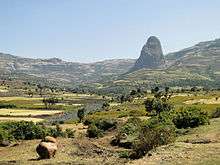Bete Amhara
Bete Amhara (Amharic: ቤተ አማራ "House of Amhara" ) was a region in Ethiopia that existed for centuries. It covered most of modern Ethiopia's south and north Wollo, significant parts of north Shewa, Gojam and Gonder zones.[1] The state had 30 districts, including Ambassel, Lakomelza, Laikueyta, Tatakuyeta, Akamba, Anbasit, Atronsa Mariam, Genete-Giorigis, Feresbahir (most probably located in the northern part of Dessie, where there is a small lake called Feres Bahir or Bahir Shasho), Amba Gishen, Gishe Bere, Wasal, Wagada, Mecana-Selasse, Tabor, Tedbaba Mariam, Zoramba, Daje, Demah, Ephrata and Ewarza.[2][3] The region is the source of much of Ethiopia's clothing culture, eating culture, language, education system.[4][5]

History
With the rise of the so-called Solomonic Dynasty in 1270 under Emperor Yekuno Amlak (born in the Maqdalla region) and until the establishment of Gondar as the new imperial capital around 1600, the Debre-Birhan to Mekane-Selassie region was the primary seat of the roving Wolloye-Shewan emperors. This period is most significant in the formation of the medieval Ethiopian state, the spread and consolidation of Ethiopian Orthodox Christianity (following the example set by the Zagwe kings in preserving the Axumite heritage) and propagating to the core provinces (besides Tigray/Eritrea, Wolkayt, and Lasta) of Bete Amhara, Gojam, Begemdir, northern Shewa, Gafat, and Damot[6]
The region’s recorded history, in fact, goes back to the first decades of the second millennium. For example, St. George’s Church in the town of Woreilu (whose Tabot is reputed to have been carried by Emperor Menelik at the Battle of Adwa) was established around 1200. The parish of Mekane Selassie (መካነ ስላሴ), near Neded and the home of the famous cathedral by the same name, served as a favorite royal playground. The construction of Mekane Selassie (meaning: the abode of the Trinity) was begun by Emperor Naod (1494-1508) and completed by his son Emperor Libna Dengel (royal nom-du-guerre, Wanag Seged). This was a year before the church (along with a large number of monasteries in the region) was sacked and burned down in 1531 by the infamously destructive Jihad led by Ahmad bin Ibrahim (aka Ahmed Gragn).
Francisco Alvarez, who had earlier visited the church, confirms that its size was some 150 feet by 150 feet—wholly covered in gold leaf, inlaid with gems, pearls and corals[7]
Astounded by the wealth and workmanship, the Yemeni chronicler of Ahmed Gragn notes: "The imam asked all the Arabs who were with him, ‘Is there the like of this church, with its images and its gold, in Byzantium, or in India, or in any other place?' They replied, ‘We never saw or heard of its like in Byzantium or India or anywhere in the world.[8] The field on which Gragn’s soldiers encamped is still called Gragn Meda along with a big hole in the ground which is mythologized by the traumatized population as the spot where Gragn’s horse pounced with all his force.
Abba Gregorius (1596-1658), the famous monk whose Jesuit association and global travels disseminated invaluable knowledge overseas about Ethiopia, is said to hail from Woreilu. In a 1650 letter to the German scholar Hiob Ludolf (1624-1704), the Ethiopologist deservedly known as the father of Ethiopian Studies, Abba Gregorius describes himself as follows: "As to my origins, do not imagine, my friend, that they are humble, for I am of the House of Amharawhich is a respected tribe; from it come the heads of the Ethiopian people, the governors, the military commanders, the judges and the advisers of the King of Ethiopia who appoint and dismiss, command and rule in the name of the King, his governors, and grandees. ”[9]
See also
References
- Alvares, Francisco. (1975). The Prester John of the Indies; a true relation of the lands of the Prester John, being the narrative of the Portuguese embassy to Ethiopia in 1520. Kraus. OCLC 2313033.
- Travels to Discover the Source of the Nile, In the Years 1768, 1769, 1770, 1771, 1772 and 1773, Third edition, 8 volumes; Ed., Alexander Murray; Edinburgh, 1813
- Vincenzo Maria Coronelli, August 1650, Venedig, Paris (1681 bis 1683)
- A Voyage to Abyssinia by Jerome Lobo, Library of Alexandria
- Crone, G. R.; Beckingham, C. F.; Huntingford, G. W. B.; Alvarez, Francisco (March 1962). "The Prester John of the Indies. The Prester John of the Indies. A True Relation of the Lands of Prester John, Being the Narrative of the Portuguese Embassy to Ethiopia in 1520". The Geographical Journal. 128 (1): 91. doi:10.2307/1794138. ISSN 0016-7398.
- Blackhurst, Hector (October 1974). "Church and State in Ethiopia, 1270–1527. By Taddesse Tamrat. Oxford: Clarendon Press, 1972. Pp. xv + 327, bibl., ill., maps. £5·50". Africa. 44 (4): 427–428. doi:10.2307/1159069. ISSN 0001-9720.
- Beckingham, C.F.; Huntingford, G.W.B., eds. (2017-05-15). "The Prester John of the Indies". doi:10.4324/9781315554013. Cite journal requires
|journal=(help) - "Futūḥ al-Ḥabasha". Christian-Muslim Relations 1500 - 1900. Retrieved 2019-12-30.
- Pankhurst, Richard (1965). "Guns in Ethiopia". Transition (20): 26. doi:10.2307/2934388. ISSN 0041-1191.